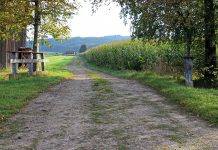WEST LAFAYETTE, Ind. — People are often prescribed a multi-vitamin or medication or two to help them perform and feel their best every day. Now, some farmers are doing the same for their fields. It’s called prescription farming.
Very precise
They’re not giving vitamins or medication to the land, necessarily, but this type of farming allows farmers to be very precise and only apply or plant what’s needed to get optimum results.
Eric Wappel of Wappel Farms in San Pierre, Ind., is all about prescription farming. The Wappel Farm sits in the Kankakee River Watershed in northern Indiana where there are many different soil types — everything from muck to sand.
Eric farms with his father and brother, Larry and Larry Jr. Together, they farm 2,600 acres of corn, 2,600 acres of soybeans and 800 acres of mint.
“We have up to 25 different soil types in our fields and each one is unique,” Eric said. “So each soil type should be farmed differently. Some soils require increased plant populations or less anhydrous or phosphate than others.
“Prescription farming lets me farm every acre in a 20-acre field instead of farming 20 acres.”
For example, the Wappels have a 20-acre field that goes from muck to sand. On the sandiest soil, Eric plants 20,000 corn seeds per acre and on the muck soils he plants 34,000 seeds per acre.
John Deere APEX
Using the John Deere APEX computer program, Eric assigns prescriptions and then only applies what is needed to a field. Working with Matt Gilsinger of Gilsinger Implement Co. Inc., the Wappels implemented the newest technology available from John Deere.
“Their GPS system includes Swath Control Pro, which allows for automatic turn on and shut off to prevent overlap, and AutoTrac, automatic steering with 2-4 inch accuracy,” Gilsinger said.
Clinics
Gilsinger offers two to three clinics a year focusing on different aspects of using the technology, including how to navigate the screen, how to set up tasks for recording and how to make a prescription operate.
“The only thing I tell farmers is, ‘The more effort you put into getting data layers, the more information you’ll have to make managerial decisions,'” Gilsinger said.
Wappel spent about 50 hours this winter working with the program and making assignments to soil types within each field where he intended to plant corn.
“We started with corn, because that’s where we can best recover our costs,” Wappel said.
First thing
The first thing Wappel has to do is plot any new fields on the map. Once plotted, each field has a border around it. Then he brings up the soil maps and assigns a plant population or anhydrous rate to each soil type.
After saving the information to a flash card or memory stick, he plugs it into the tractor’s monitor. When he gets to the field, the computer and controllers automatically control and change the rates as he progresses in the field, based on soil type and the assignment made.
“The GPS always knows where I am in the field,” Wappel said.
He admits it takes some to assign all the prescriptions each year, because they change as the seed technology and other products change.
A lot of research
“I do a lot of research on population studies and take yield experience or knowledge of certain fields into consideration,” Wappel said. “Our average field size is about 30 acres and I wrote a prescription for all 2,600 acres for both corn population and anhydrous.”
Last year was Wappel’s first year to write a prescription for corn populations and this year is their first to apply it to anhydrous, but they’ve been doing it since 2002 for fertilizer and lime.
The Wappels irrigate and he said he can mark the placement of their center-pivot irrigation system and increase seeding rate accordingly.
“It’s a pretty large investment upfront to get set up, but in the end it’s worth it,” he said. “We’re already seeing higher yields in the sand because we are not over-populating and we’re saving a lot of money on anhydrous, too.”
Initial investment
Wappel thinks they’ll recover their initial investment this year after using prescription farming technology only two years.
“It’s not for everyone, but it just makes sense for us because we have so many different soil types,” he said. “But if you’re a farmer that farms only one or two soil types, it may not be worth the investment.”









